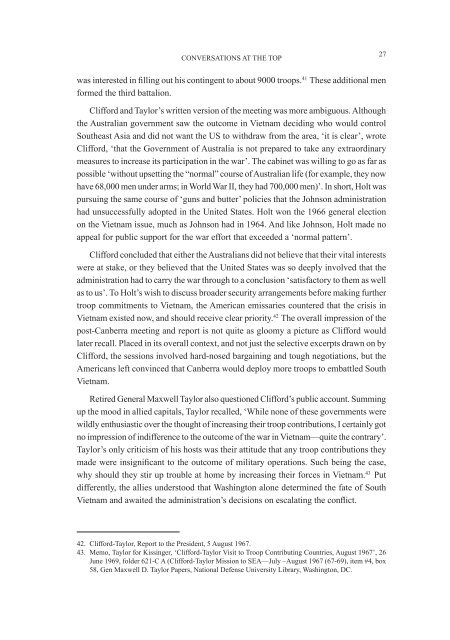conference proceedings - Australian Army
conference proceedings - Australian Army
conference proceedings - Australian Army
Create successful ePaper yourself
Turn your PDF publications into a flip-book with our unique Google optimized e-Paper software.
CONVERSATIONS AT THE TOP<br />
was interested in filling out his contingent to about 9000 troops. 41 These additional men<br />
formed the third battalion.<br />
Clifford and Taylor’s written version of the meeting was more ambiguous. Although<br />
the <strong>Australian</strong> government saw the outcome in Vietnam deciding who would control<br />
Southeast Asia and did not want the US to withdraw from the area, ‘it is clear’, wrote<br />
Clifford, ‘that the Government of Australia is not prepared to take any extraordinary<br />
measures to increase its participation in the war’. The cabinet was willing to go as far as<br />
possible ‘without upsetting the “normal” course of <strong>Australian</strong> life (for example, they now<br />
have 68,000 men under arms; in World War II, they had 700,000 men)’. In short, Holt was<br />
pursuing the same course of ‘guns and butter’ policies that the Johnson administration<br />
had unsuccessfully adopted in the United States. Holt won the 1966 general election<br />
on the Vietnam issue, much as Johnson had in 1964. And like Johnson, Holt made no<br />
appeal for public support for the war effort that exceeded a ‘normal pattern’.<br />
Clifford concluded that either the <strong>Australian</strong>s did not believe that their vital interests<br />
were at stake, or they believed that the United States was so deeply involved that the<br />
administration had to carry the war through to a conclusion ‘satisfactory to them as well<br />
as to us’. To Holt’s wish to discuss broader security arrangements before making further<br />
troop commitments to Vietnam, the American emissaries countered that the crisis in<br />
Vietnam existed now, and should receive clear priority. 42 The overall impression of the<br />
post-Canberra meeting and report is not quite as gloomy a picture as Clifford would<br />
later recall. Placed in its overall context, and not just the selective excerpts drawn on by<br />
Clifford, the sessions involved hard-nosed bargaining and tough negotiations, but the<br />
Americans left convinced that Canberra would deploy more troops to embattled South<br />
Vietnam.<br />
Retired General Maxwell Taylor also questioned Clifford’s public account. Summing<br />
up the mood in allied capitals, Taylor recalled, ‘While none of these governments were<br />
wildly enthusiastic over the thought of increasing their troop contributions, I certainly got<br />
no impression of indifference to the outcome of the war in Vietnam—quite the contrary’.<br />
Taylor’s only criticism of his hosts was their attitude that any troop contributions they<br />
made were insignificant to the outcome of military operations. Such being the case,<br />
why should they stir up trouble at home by increasing their forces in Vietnam. 43 Put<br />
differently, the allies understood that Washington alone determined the fate of South<br />
Vietnam and awaited the administration’s decisions on escalating the conflict.<br />
42. Clifford-Taylor, Report to the President, 5 August 1967.<br />
43. Memo, Taylor for Kissinger, ‘Clifford-Taylor Visit to Troop Contributing Countries, August 1967’, 26<br />
June 1969, folder 621-C A (Clifford-Taylor Mission to SEA—July –August 1967 (67-69), item #4, box<br />
58, Gen Maxwell D. Taylor Papers, National Defense University Library, Washington, DC.<br />
27

















